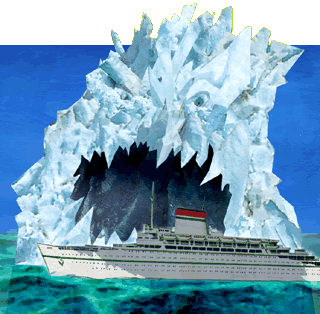
Aflotilla of enormous white marauders sneaks out of their frozen lair to attack peaceful ships and ravage humanity. Vikings? No. Icebergs? Yes! The cold, albino monsters have terrorized us for centuries -- at least 200 vessels have been devoured by Titanic-biting chunks.
Modern weaponry has turned the tide, though -- berg-battlers like the U.S. Coast Guard now easily cripple most freshwater cubes. Small bergs are exploded, hot-water hosed, laser-beamed, harpooned, lassoed, towed, and crushed against rocky cliffs by pugnacious tugboats. Big bergs that can't be effectively bludgeoned like baby seals are tracked with radar, to alert sailors of their precise coordinates. Our feud with the jumbo Popsicles isn't over yet, though -- Alas!
The ghostly behemoths have concocted a sinister, new strategy: They'll drown our harbors and flood our lowlands! Will global warming slide massive ice-blocks into the ocean, raising sea level 74 meters? Will The Great Flood return? Maybe, maybe not. Climatologists are divided -- some say there will be surf property in Missouri, while others argue that the "greenhouse theory" is a fraud perpetuated by eco-paranoids and the gullible media.
Arctic bergs aren't relevant in the next ice age, because they represent only 10% of worldwide ice mass. But it's another story in the Southern Hemisphere. Antarctica is where the giant ice dwells, and it seems to be stirring.
This movement is due to a climbing temperature -- up 2.5 degrees Celsius on the Antarctic Peninsula in the last fifty years. Fat slabs huddled here contain a fierce latent power, especially when Greenpeace warns that they're "rapidly disintegrating." The British Antarctic Survey also insists that ice shelves are "nearing the limits of stability."
In 1998 a Delaware-sized chunk of the Ronne Ice Shelf flung itself into the sea (a moaning process called "calving.") A berg the breadth of Rhode Island swam off the Larsen Ice Shelf in 1995, and a shard of Massachusetts dimensions splashed in from the Ross Ice Shelf in 1987. Ocean levels don't rise when dinky New England states plunge in -- they're only a drop in the bucket. But if the entire Ross Ice Shelf -- a Texas-sized blob -- tosses itself into the waves, it would be a worldwide dike-destroying event.
The Larsen B ice cap is also cracking; this could spew a snowball the size of Vermont and New Hampshire. Rudi del Valle, director of the Argentinean Antarctic Institute, predicts the demise of the Larsen B in two years. The USA's Environmental Defense Fund projects "a 13-20 foot rise in sea level and major coastal flooding" in the next century if thick, frozen Texas slides in. A 20-foot rise would flood every harbor in the world. If the entire Antarctic ice cap (an area the size of USA and Mexico, with an approximate average thickness of 1.5 miles) dives in like a penguin, the resultant high tide would drown entire nations like Holland and Bangladesh.
Is this doomsday talk just gobbledygook? Skeptics sniff that global warming is a hoax, promulgated by inferior, figure-fudging statisticians. The 1999 Intergovernmental Panel on Climate Change states that "the likelihood of a major sea level rise by the year 2100... is considered low." The European Space Agency also determined that "the Antarctic ice cap is stable and will remain stable for the foreseeable future."
What about the huge, recent "calves?" Big bergs have always been around, remarks Paul Jensen in junkscience.com. In 1956, for example, a Maryland-sized blob was discovered. Ted Scambos of the University of Colorado also considers the recent activity "unlikely to be climate-related."
So, can we domesticate icebergs, instead of fearing them? Yes, claim a number of entrepreneurs and engineers. Pure iceberg water is presently packaged by "Canada's Original Iceberg Water Corporation" in St. John's, Newfoundland, and "flat-top" bergs were proposed as "natural" aircraft carriers by the British in World War II (this plan never thawed out). Saudi Arabia's King Khaled wanted to tow icebergs to his thirsty nation, but the estimated $80 million cost squelched his wet dream.
Patrick Quilty of the Australian Antarctic Division suggested iceberg relief to Africa in 1997, and Robert Banks' 1998 book Towing Icebergs, Falling Dominoes, and Other Adventures in Applied Mathematics, advanced a similar ploy for Southern California. How much water is trapped in these mounds? Guy Guthridge, a National Science Foundation official, deduced that harvesting the 1987 "Massachusetts" ice block would supply "all the water needs of Los Angeles for the next 675 years." The berg contained 1.4 trillion tons of pure water -- 240 tons for every human on the globe.
So are icebergs our friends? Or evil fiends? Only the next century will unveil this answer. Right now, it's still anybody's guess.
Hank Hyena is a columnist at Sfgate.com and a regular contributor to Salon.
